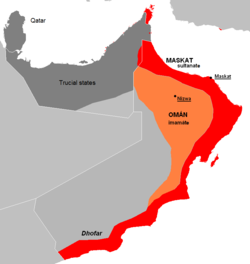
Back Verdragskus AF إمارات الساحل المتصالح Arabic Estaos de la Tregua AST Atəşkəs dövlətləri AZ চুক্তিবদ্ধ রাষ্ট্র Bengali/Bangla Estats de la Treva Catalan Vertragsoman German Ŝtatoj de Batalhalto EO Estados de la Tregua Spanish Tregoaren Estatuak EU
Trucial States | |||||||||||||||||||||||
|---|---|---|---|---|---|---|---|---|---|---|---|---|---|---|---|---|---|---|---|---|---|---|---|
| 1820–1971 | |||||||||||||||||||||||
|
Flag of the Trucial States Council (1968–1971) | |||||||||||||||||||||||
 The Trucial States in the 20th century shown in Dark Gray | |||||||||||||||||||||||
| Status | Persian Gulf Residency of India (1820–1947) British Protectorate (1947–1971) | ||||||||||||||||||||||
| Capital | Abu Dhabi | ||||||||||||||||||||||
| Common languages | Arabic English | ||||||||||||||||||||||
| Religion | Sunni Islam | ||||||||||||||||||||||
| Demonym(s) | Trucials[1] | ||||||||||||||||||||||
| Government | Tribal confederation(s) | ||||||||||||||||||||||
| Historical era | New Imperialism to Cold War | ||||||||||||||||||||||
| 8 January 1820 | |||||||||||||||||||||||
| 4 May 1853 | |||||||||||||||||||||||
| 21 March 1952 | |||||||||||||||||||||||
| 1 December 1971 | |||||||||||||||||||||||
| 2 December 1971 | |||||||||||||||||||||||
| Currency | Ottoman Lira (1820–1899)[2] Indian Rupee (1899–1959) Gulf Rupee (1959–1966) Bahraini Dinar (1966–1971) | ||||||||||||||||||||||
| |||||||||||||||||||||||
| Today part of | |||||||||||||||||||||||
| This article is part of a series on the |
| History of the United Arab Emirates |
|---|
 |
|
|
The Trucial States (Arabic: الإمارات المتصالحة, romanized: Al-Imārāt al-Mutaṣāliḥa), also known as the Trucial Coast (Arabic: الساحل المتصالح, romanized: Al-Sāḥil al-Mutaṣāliḥ), the Trucial Sheikhdoms (Arabic: المشيخات المتصالحة, romanized: Al-Mashyakhāt al-Mutaṣāliḥa), Trucial Arabia or Trucial Oman, was a group of tribal confederations to the south of the Persian Gulf (southeastern Arabia) whose leaders had signed protective treaties, or truces, with the United Kingdom between 1820 and 1892.[3]
The Trucial States remained an informal British protectorate until the treaties were revoked on 1 December 1971. The following day, six of the sheikhdoms—Dubai, Abu Dhabi, Sharjah, Ajman, Umm Al Quwain and Fujairah—formed the United Arab Emirates; the seventh, Ras Al Khaimah, joined on 10 February 1972.[3]
- ^ Winder, Bayly (1965). Saudi Arabia in the Nineteenth Century. p. 33.
- ^ Taryam, Abdulla Omran (2019). The Establishment of the United Arab Emirates 1950-85. Routledge. p. 59.
- ^ a b "United Arab Emirates - Gulf, Sheikhdoms, Federation | Britannica". www.britannica.com. 16 June 2024. Retrieved 16 June 2024.
